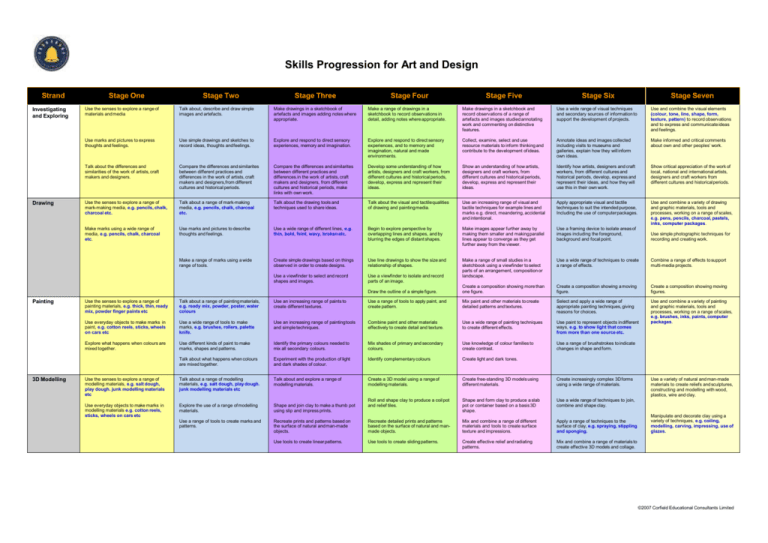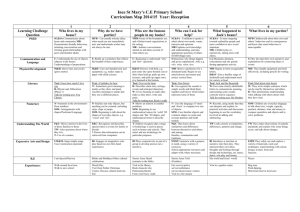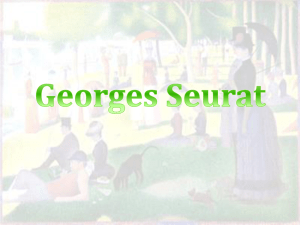Strand
advertisement

Skills Progression for Art and Design Strand Investigating and Exploring Drawing Painting 3D Modelling Stage One Stage Two Stage Three Stage Four Stage Five Stage Six Stage Seven Use the senses to explore a range of materials and media Talk about, describe and draw simple images and artefacts. Make drawings in a sketchbook of artefacts and images adding notes where appropriate. Make a range of drawings in a sketchbook to record observations in detail, adding notes where appropriate. Make drawings in a sketchbook and record observations of a range of artefacts and images studied annotating work and commenting on distinctive features. Use a wide range of visual techniques and secondary sources of information to support the development of projects. Use and combine the visual elements (colour, tone, line, shape, form, texture, pattern) to record observations and to express and communicate ideas and feelings. Use marks and pictures to express thoughts and feelings. Use simple drawings and sketches to record ideas, thoughts and feelings. Explore and respond to direct sensory experiences, memory and imagination. Explore and respond to direct sensory experiences, and to memory and imagination, natural and made environments. Collect, examine, select and use resource materials to inform thinking and contribute to the development of ideas. Annotate ideas and images collected including visits to museums and galleries, explain how they will inform own ideas. Make informed and critical comments about own and other peoples’ work. Talk about the differences and similarities of the work of artists, craft makers and designers. Compare the differences and similarites between different practices and differences in the work of artists, craft makers and designers,from different cultures and historical periods. Compare the differences and similarites between different practices and differences.in the work of artists, craft makers and designers, from different cultures and historical periods, make links with own work. Develop some understanding of how artists, designers and craft workers, from different cultures and historical periods, develop, express and represent their ideas. Show an understanding of how artists, designers and craft workers, from different cultures and historical periods, develop, express and represent their ideas. Identify how artists, designers and craft workers, from different cultures and historical periods, develop, express and represent their ideas, and how they will use this in their own work. Show critical appreciation of the work of local, national and international artists, designers and craft workers from different cultures and historical periods. Use the senses to explore a range of mark-making media, e.g. pencils, chalk, charcoal etc. Talk about a range of mark-making media, e.g. pencils, chalk, charcoal etc. Talk about the drawing tools and techniques used to share ideas. Talk about the visual and tactile qualities of drawing and painting media. Use an increasing range of visual and tactile techniques for example lines and marks e.g. direct, meandering, accidental and intentional. Apply appropriate visual and tactile techniques to suit the intended purpose, Including the use of computer packages. Use and combine a variety of drawing and graphic materials, tools and processes, working on a range of scales, e.g. pens, pencils, charcoal, pastels, inks, computer packages. Make marks using a wide range of media, e.g. pencils, chalk, charcoal etc. Use marks and pictures to describe thoughts and feelings. Use a wide range of different lines, e.g. thin, bold, feint, wavy, broken etc. Begin to explore perspective by overlapping lines and shapes, and by blurring the edges of distant shapes. Make images appear further away by making them smaller and making parallel lines appear to converge as they get further away from the viewer. Use a framing device to isolate areas of images including the foreground, background and focal point. Use simple photographic techniques for recording and creating work. Make a range of marks using a wide range of tools. Create simple drawings based on things observed in order to create designs. Use line drawings to show the size and relationship of shapes. Use a wide range of techniques to create a range of effects. Combine a range of effects to support multi-media projects. Use a viewfinder to select and record shapes and images. Use a viewfinder to isolate and record parts of an image. Make a range of small studies in a sketchbook using a viewfinder to select parts of an arrangement, composition or landscape. Draw the outline of a simple figure. Create a composition showing more than one figure. Create a composition showing a moving figure. Create a composition showing moving figures. Use and combine a variety of painting and graphic materials, tools and processes, working on a range of scales, e.g. brushes, inks, paints, computer packages. Use the senses to explore a range of painting materials, e.g. thick, thin, ready mix, powder finger paints etc Talk about a range of painting materials, e.g. ready mix, powder, poster, water colours Use an increasing range of paints to create different textures. Use a range of tools to apply paint, and create pattern. Mix paint and other materials to create detailed patterns and textures. Select and apply a wide range of appropriate painting techniques, giving reasons for choices. Use everyday objects to make marks in paint, e.g. cotton reels, sticks, wheels on cars etc Use a wide range of tools to make marks, e.g. brushes, rollers, palette knife. Use an increasing range of painting tools and simple techniques. Combine paint and other materials effectively to create detail and texture. Use a wide range of painting techniques to create different effects. Use paint to represent objects in different ways, e.g. to show light that comes from more than one source etc. Explore what happens when colours are mixed together. Use different kinds of paint to make marks, shapes and patterns. Identify the primary colours needed to mix all secondary colours. Mix shades of primary and secondary colours. Use knowledge of colour families to create contrast. Use a range of brushstrokes to indicate changes in shape and form. Talk about what happens when colours are mixed together. Experiment with the production of light and dark shades of colour. Identify complementary colours Create light and dark tones. Use the senses to explore a range of modelling materials, e.g. salt dough, play dough. junk modelling materials etc Talk about a range of modelling materials, e.g. salt dough, play dough. junk modelling materials etc Talk about and explore a range of modelling materials. Create a 3D model using a range of modelling materials. Create free-standing 3D models using different materials. Create increasingly complex 3D forms using a wide range of materials. Use everyday objects to make marks in modelling materials e.g. cotton reels, sticks, wheels on cars etc Explore the use of a range of modelling materials. Shape and join clay to make a thumb pot using slip and impress prints. Roll and shape clay to produce a coil pot and relief tiles. Shape and form clay to produce a slab pot or container based on a basis 3D shape. Use a wide range of techniques to join, combine and shape clay. Use a range of tools to create marks and patterns. Recreate prints and patterns based on the surface of natural and man-made objects. Recreate detailed prints and patterns based on the surface of natural and manmade objects. Mix and combine a range of different materials and tools to create surface texture and impressions. Apply a range of techniques to the surface of clay, e.g. spraying, stippling and sponging. Use tools to create linear patterns. Use tools to create sliding patterns. Create effective relief and radiating patterns. Mix and combine a range of materials to create effective 3D models and collage. Use a variety of natural and man-made materials to create reliefs and sculptures, constructing and modelling with wood, plastics, wire and clay. Manipulate and decorate clay using a variety of techniques, e.g. coiling, modelling, carving, impressing, use of glazes. ©2007 Corfield Educational Consultants Limited Printing Use the senses to explore a range of printing materials and tools, e.g. found objects, potatoe prints etc. Talk about a range of printing materials and tools, e.g. found objects, potato prints etc. Talk about and recreate patterns in the environment. Compare and recreate shapes and patterns in nature and the environment. Create and use shapes and patterns in nature, the environment and different cultures and times. Use and incorporate shapes and patterns in nature, the environment and different cultures and times. Use everyday objects to make marks. e.g. cotton reels, sticks, wheels on cars etc Use an increasing range of everyday objects to create marks and patterns. Make prints and patterns using everyday natural and man-made objects. Talk about the ways in which patterns are made, e.g. overlapping of shapes, repeats. Talk about geometric, symmetrical and asymmetrical patterns. Talk about and evaluate a wide range of complex patterns, e.g. the work of Esher. Use string to create symmetrical string pulled pictures. Cut a simple shape into card to create a stencil. Make prints based on surfaces taken from the environment. Create surface texture using rollers, sponges, engraving and by printing from an inked surface. Create complex surface textures by mixing and combining techniques. Make a simple paper stencil. Make a 2 part paper stencil. Make a multi-layered stencil. Make a simple printing block. Make a 2 colour block print. Make a multi-coloured block print. Use string and glue to make a simple printing block. Use a variety of printing techniques and methods, e.g. mono/block printing techniques and various screen printing methods. ©2007 Corfield Educational Consultants Limited Textiles Use the senses to explore a range of textiles and materials e.g.wool, cotton, felt etc. Talk about a range of textiles and materials e.g.plain patterned, textured etc. Use and talk about natural and manmade materials. Apply one material to the surface of another a material (appliqué). Use an increasing range of decorative techniques, e.g. fabric paints and dye, folds, pleats, beads etc. Use quilting, wire, padding and appliqué to support 3D projects. Use a range of every day fabrics and materials to create pictures. Plan and create multi-media pictures and collages. Draw a simple picture to represent a plan. Create a simple design and transfer the main shapes to a paper pattern. Create a simple paper pattern including a seam allowance. Create a simple paper pattern including accurate measurements. Use a range of materials to create largescale models, weavings and collage. Use a range of materials to create pictures and collage. Use running stitch. Use overstitch and cross stitch. Use blanket stitch, herringbone and embroidery. Create simple symmetrical patterns. Create a simple repeating pattern, e.g. over, under, over, under. Talk about the work of important crafts and design people. Talk about and recreate the techniques of important crafts and design people throughout history. Recreate and use the techniques of important crafts people throughout history. Use a bobbin to create a simple wool chain. Use a card loom. Make a simple loom and use different materials to produce a range of weft threads. Create a range of weft patterns on a range of different sized looms. Create and use a wide range of materials, techniques and patterns to create a large-scale weaving project. Work with textiles using a variety of materials, tools and techniques, e.g. painting, dyeing, weaving, felting, stitching, quilting, applique and collage ©2007 Corfield Educational Consultants Limited





